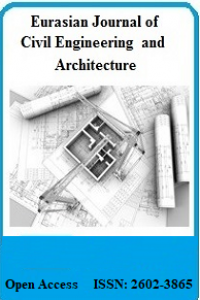Effects of Dimensions of Tire Waste Cushion on Seismic Performance of Retaining Wall
Effects of Dimensions of Tire Waste Cushion on Seismic Performance of Retaining Wall
___
- Bathurst, R.J., Zarnani, S. & Gaskin A. 2007. Shaking table testing of geofoam seismic buffers. Soil Dynamics and Earthquake Engineering, 27(4), 324–332. Cagatay, A. 2008. Investigation of the effect of tire waste inclusions on the shear strength parameters of sand, MSc Thesis, Boğaziçi University (in English).
- Edinçliler, A. & Toksoy Y.S. 2014. Investigation on Effects of Tire Crumb Cushion on Seismic Performance of Retaining Wall. TC207 Soil Structure Interaction and Retaining Walls, 16-18 June, St. Petersburg, Russia.
- Edinçliler, A. & Toksoy Y.S. 2017. Effects of Ground Motion Characteristics on the Seismic Performance of Retaining Walls with Tire Waste Cushion. 16th World Conference on Earthquake Engineering, 16WCEE 2017 Santiago Chile.
- Edincliler, A. 2008. Using waste tire–soil mixtures for embankment construction. In: International Workshop on Scrap Tire Derived Geomaterials ‘‘Opportunities and Challenges”. Kanto Branch of Japanese Geotechnical Society, 319–328.
- Edinçliler, A., Baykal, G., & Saygılı A. 2010. Influence of different processing techniques on the mechanical properties of used tires in embankment construction. Waste Management, 30, 1073–1080.
- Hazarika, H., Kohama, E., & Sugano T. 2008. Shaking Table Tests on Waterfront Structures Protected with Tire Chips Cushion, Journal of Geotechnical and Environmental Engineering, ASCE, 134-11.
- Hazarika, H., Okuzono, S., & Matsuo Y. 2003. Seismic stability enhancement of rigid nonyielding structures. In: Proceedings of the 13th (2003) International Offshore and Polar Engineering Conference, Honolulu, HI, USA, 25–30 May 2003, 1244–1249.
- Horvath, J.S. 1997. Compressible inclusion function of EPS geofoam. Geotextiles and Geomembranes, 15(1-3), 77–120.
- Karpurapu, R. & Bathurst R.J. 1992. Numerical investigation of controlled yielding of soil-retaining wall structures. Geotextiles and Geomembranes, 11, 115–31.
- Partos, A.M. & Kazaniwsky P.M. 1987. Geoboard reduces lateral earth pressures. In: Proceedings of Geosynthetics’87, Industrial Fabrics Association International. New Orleans, LA, USA, 628–39.
- Pierce, C.E. & Blackwell M.C. 2003. Potential of scrap tire rubber as lightweight aggregate in flowable fill. Waste Management, 23, 197–208.
- Ravichandran, N. & Huggins L. 2014. Applicability of Shredded Tire Chips as a Light Weight Retaining Wall Backfill in Seismic Regions. Geo-Congress 2014, 3336-3505.
- Yildiz, O. 2012. Investigation on the mitigation of earthquake hazards with inclusion of tire wastes into the sand. M.Sc. Dissertation, Boğaziçi University, Istanbul, Turkey.
- Zarnani, S., & Bathurst R.J. 2008. Numerical Modelling of EPS Seismic Buffer Shaking Table Tests. Geotextiles and Geomembranes, 26, 371– 383.
- Zarnani, S., & Bathurst R.J. 2007. Experimental investigation of EPS geofoam seismic buffers using shaking table tests. Geosynthetics International, 14(3), 165–177.
- Zarnani, S., Bathurst, R.J. & Gaskin A. 2005. Experimental investigation of geofoam seismic buffers using a shaking table. In: Proceedings of the North American Geosynthetics Society (NAGS)/GRI19 Conference, Las Vegas, NV, USA.
- Başlangıç: 2017
- Yayıncı: Serkan ŞAHİNKAYA
Identifying the Advantages of BIM in Structural Design
Nonlinear Site Response Analysis for the Izmir Region: A Case Study
Ayşe EDİNÇLİLER, Murat ÇALIKOĞLU
The Future of 3D Printing Technology in the Construction Industry: a Systematic Literature Review
Performance Characteristics of International Joint Ventures in Construction
Nonlinear and Equivalent Linear Site Response Analysis for the Bodrum Region
Ayşe EDİNÇLİLER, Gözde SEZGİN TUNCAY
Abdulkadir ÖZDEN, Ardeshir FAGHRİ
Effects of Dimensions of Tire Waste Cushion on Seismic Performance of Retaining Wall
Ayşe EDİNÇLİLER, Yasin Sait TOKSOY
Geotechnical Characterization of Alluvial Soil in Çiğli - Balatçık Region
